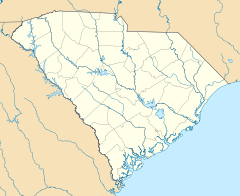- Charleston Naval Shipyard
-
Charleston Naval Shipyard North Charleston, South Carolina Type Shipyard Coordinates 32°51′47″N 79°57′59″W / 32.86306°N 79.96639°WCoordinates: 32°51′47″N 79°57′59″W / 32.86306°N 79.96639°W Built 1909 In use 1901 — 1996 - now as Detyens Shipyards Controlled by United States Navy Battles/wars Charleston Navy Yard Historic DistrictLocation: Roughly bounded by First St., Hobson Ave., Avenue D, Fourth and Fifth Sts., and the drydocks bet. First and Thirteenth S, North Charleston, South Carolina Coordinates: 32°51′38″N 79°57′53″W / 32.86056°N 79.96472°WCoordinates: 32°51′38″N 79°57′53″W / 32.86056°N 79.96472°W Area: 145 acres (59 ha) Built: 1903 Architect: multiple Architectural style: Late 19th And 20th Century Revivals, Modern Movement Governing body: Federal NRHP Reference#: 06000699[1] Added to NRHP: August 09, 2006 Charleston Naval Shipyard (formerly known as the Charleston Navy Yard) was a U.S. Navy ship building and repair facility located along the west bank of the Cooper River, in North Charleston, South Carolina and part of Naval Base Charleston. It began operations in 1901 as a drydock, and continued as a navy facility until 1996 when it was leased to Detyens Shipyards, Inc. during down-sizing.
The yard first produced the destroyer USS Tillman (DD-135), then began to increase production in the 1930s. A total of 21 destroyers were assembled at the naval facility.
In 1931, Ellicott Dredges delivered the 20-inch cutter dredge Orion still in operation at the old Charleston Naval Shipyard.
"Two of the largest vessels ever built at the yard were two destroyer tenders, the USS Tidewater (AD-31) and the USS Bryce Canyon (AD-36). The keels of these ships were laid in November 1944 and July 1945, respectively. Peak employment of 25,948 was reached in July 1943.
After the war, the shipyard was responsible for the repairs and alterations of captured German submarines. In April 1948, Secretary of the Navy John L. Sullivan told Charleston's Representative Rivers and Senator Burnet R. Maybank that the Navy planned for CNSY to become a submarine overhaul yard and would ask for an initial appropriation for a battery-charging unit.
The first submarine, the USS Conger (SS-477), arrived for overhaul in August 1948. The shipyard expected to overhaul about 132 ships during the year, and its work force had stabilized to nearly 5,000 persons.
North Korean invasion of South Korea in June 1950 increased production once again. By 1951, the shipyard was back to over 8,000 employees. In all, the shipyard activated forty-four vessels and converted twenty-seven for active fleet duty during the Korean War.
Submarines continued to be built into the 1960s along with missiles, and nuclear submarine overhauls took place like with the USS Scorpion (SSN-589) in 1962. In 1966, the shipyard completed the first refueling of a nuclear submarine, the USS Skipjack (SSN-585), and began its first overhaul of an Fleet Ballistic Missile (FBM) submarine, the USS Thomas A. Edison (SSBN-610). Work began on deepening Dry Dock No. 2 so it could handle the massive FBM submarines and destroyers fitted with sonar." [2]
The facility remained a major installation throughout the Cold War as a homeport to numerous cruisers, destroyers, attack submarines, FBM submarines, destroyer tenders and submarine tenders of the U.S. Atlantic Fleet until its closure in the 1990s as a result of the end of the Cold War and subsequent BRAC Commission action.
Today, a 340-acre (1.4 km2) section of the former base is being revitalized as a sustainable, mixed-use urban hub for the city of North Charleston. The new development is called The Navy Yard at Noisette. Ground broke in 2005.
See also
- Naval Support Activity Charleston
- Warren Lasch Conservation Center
References
- National Historic Register nomination form for the Charleston Navy Yard Historic District, South Carolina Department of Archives and History, 2006.
- ^ "National Register Information System". National Register of Historic Places. National Park Service. 2009-03-13. http://nrhp.focus.nps.gov/natreg/docs/All_Data.html.
- ^ Colletta, Paolo E., Ed.United States Navy and Marine Corps Bases, Domestic.. Greenwood Press: Westport, CT. 1985. Pgs. 78-102.
External links
U.S. National Register of Historic Places in South Carolina Lists by county Abbeville • Aiken • Allendale • Anderson • Bamberg • Barnwell • Beaufort • Berkeley • Calhoun • Charleston • Cherokee • Chester • Chesterfield • Clarendon • Colleton • Darlington • Dillon • Dorchester • Edgefield • Fairfield • Florence • Georgetown • Greenville • Greenwood • Hampton • Horry • Jasper • Kershaw • Lancaster • Laurens • Lee • Lexington • Marion • Marlboro • McCormick • Newberry • Oconee • Orangeburg • Pickens • Richland • Saluda • Spartanburg • Sumter • Union • Williamsburg • York

Lists by city Other lists Categories:- Historic districts in South Carolina
- Military facilities on the National Register of Historic Places in South Carolina
- Charleston County, South Carolina
- United States Navy shipyards
- Closed facilities of the United States Navy
- National Register of Historic Places listings in North Charleston, South Carolina
- United States Navy stubs
Wikimedia Foundation. 2010.

